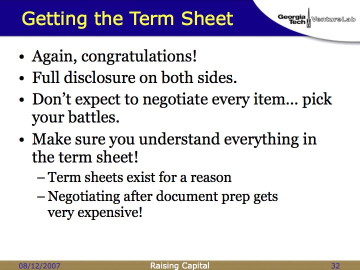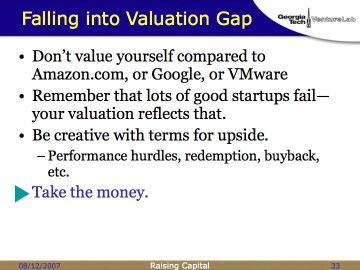Type your summary here
This is a continuation of a previous set of posts and is twelfth in a series. If I type fast enough, this will be the last installment!
Okay, you’ve written your business plan and made N pitches (where ‘N’ is a larger number than you originally expected). If you’ve done everything right, at some point, the VC will say “We like this deal; we’re going to crank out a term sheet.”
First off, a little celebration is in order. If you’re dealing with ethical VCs, a term sheet is a commitment to invest, if you can agree on the terms (that’s where the name comes from) and if they don’t find out anything devastating in the “due diligence” process. (Yep, you knew those old felony convictions would come back to haunt you someday! 🙂
So, congratulations. Now, don’t screw up.
The basic terms are the ones you would expect: How much money are they paying, for how many shares of stock, and how many board seats. The first two (dollars and shares), together with your existing capital structure, define your company’s valuation. The board arrangement defines your governance. Those are always negotiable, within certain limits, and it’s not amateurish to push back on those. Ditto for liquidation preferences.
(Within certain limits: If they’re suggesting that they have three seats on a five-person board, you can suggest that they have two, you and your management team have two, and you’ll mutually agree on a fifth from outside. You probably can’t suggest that they get one seat and you get four. See the difference?)
Beyond the basics, the right way to negotiate a term sheet is to practice full disclosure on both sides. If you hand them material surprises at this point, you might be able to survive; if you wait until after the documents are signed, you’re going to sued for rescission.
Note that the VC needs to be reciprocal. The term sheet needs to lay out everything they think they’re getting for their investment; this isn’t the time to be saying “Oh, we’ll work out those details later.”
You may be surprised by the number of terms, with titles like “Right of Co-Sale” and “Liquidation Preferences” and “Key Person Insurance.” There are a few leading law firms that prepare a significant fraction of the term sheets in circulation, and they all talk to each other. If a particular deal goes bad, there is a scramble to paper over that particular failure mechanism in the term sheet for the next deal. Such fixes are cumulative. (This is a process akin to fixing bugs in software, except that you are dealing with self-aware mutating bugs.)
Term sheets originally fit on a single sheet of paper. When I started in the VC business around 1995, term sheets had evolved to about six pages. Now, they run about twelve pages. Every paragraph on those twelve pages represents scar tissue from someone’s bad deal somewhere.
One corollary of this situation is that a particular VC firm has evolved to using a particular term sheet template over time, and they’re not going to tear it up and go back to a one-page set of terms just for you.
You might not like their “Right of First Refusal” on selling your shares. But if your VC (or another VC client sharing the same law firm) has ever had a founder sell out early because they didn’t have this term (check out the history between CraigsList and eBay), you can bet this will be in their term sheet, and it’s not going away.
Pick your battles. Get the valuation and governance right, then go focus on making your company a huge success. Most of those twelve pages are there to protect the VC for deals that go sideways, downwards, or bankrupt. It’s amazing how many of the restrictions and negative covenants just disappear for a successful company.
Final note: Term sheets exist for a reason. I usually describe term sheets as “12-page documents written in a language remarkably similar to English.” These lead to 300-page purchase agreements written in language remarkably unlike English… but that 300-page document will be the legally-binding instrument. The right time to learn what all those paragraphs and clauses mean is while you’re still looking at 12 pages.
For example, you may see a “Drag-Along Agreement” that reads something like this:
The holders of the Common Stock and Series A Preferred shall enter into a drag-along agreement whereby if a majority of the holders of Series A Preferred agree to a sale or liquidation of the Company, the holders of the remaining Series A Preferred and Common Stock shall consent to and raise no objections to such sale.
Now, if you want to argue over this (perhaps you want it to be a majority of all shareholders voting as-converted, or a 75% supermajority of the Series A, or a majority of the Series A plus a majority of the board, or whatever), you’re within your rights to try and negotiate it. You may or may not win, but you can have a conversation directly with the VC about it.
If you wait to point out that you don’t like that particular form of drag-along until after that single sentence has mutated into two pages of legalese… Now you spin up your $400/hour lawyer, and the VC spins up his or her $500/hour lawyer, and they will merrily go argue at a combined cost of $900/hour. Did I mention that the company (that’s you!) pays legal costs?
Brad Feld has done a fabulous job of writing up individual terms here, and I am not sure if I can add any real value to his version. If there are particular questions, put ’em in comments or email and I’ll see what I can do.
Entrepreneurs and VCs always disagree on valuation. You think you’re worth $20 million, and the VC thinks you’re worth $1 million. The right answer is, you’re worth what the market will bear. And if the market is bringing the money, you need to listen to what they’re saying. (Assuming, of course, that you need their money. If you don’t, why are you on Part 12 of this series?!??!)
If you’ve done everything else right (targeting the right VCs, selling your company instead of the product, etc.), then you will have definitively established a market price, because you’re in discussions with the right purchasers.
There really isn’t a science to valuing a seed-stage company. This drives left-brain types absolutely batty. You try to orchestrate a valuation that leaves everyone with a reasonable piece of the pie… typically, after the Series A, it would be typical to see the VCs with 40% of the company, the founders with 40%, and the employee option pool at 20%. But don’t game the system… don’t try to raise $5M if you only need $1M, just to value your stake at a higher price. That will get noticed.
You will occasionally see discussions like this one from Michael Blake at Adams Capital:
If you want to get more technical, I would price a seed stage company using a call option pricing model – specifically, the binomial option pricing model. This is how pharmaceutical companies have been pricing R&D projects for years, and we use that model frequently to value intellectual property. And if you think about it, almost all the val
ue in a seed stage company is the IP. And, the binomial option intuitively follows the “all or nothing” nature of venture investments (or you can use trinomial for all, nothing, and mediocre return trajectories if you prefer). For the inputs, take implied volatility of micro-cap public comps (available through Bloomberg) and convert to binomial volatility (there is a formula for this). For time to option expiration, choose a time to exit. For current price, take the expected (hoped) cash flows coming back to the investors, discounted back to today (probably at a rate of around 80%) For the exercise price, take the present value of expected future investments. Of course, you’re still at the “problem” of the uncertainty of future cash flows, but the stock volatility and the high discount rates help price in that uncertainty. The result generated by this Cox-Rubenstein model is before discounts for lack of marketability/liquidity (for seed stage companies, at least 50% for seed stage) or lack of control (at least 20%).
And, at the end of the day, you’ll still converge on a model where the VCs value you like livestock: $1 million per founder, to a maximum of $3 million.
Here’s a hint: Lots of the most onerous terms (high liquidation preferences, etc.) are to protect the VC against downside risk. And, unlike most investments, the downside for VC-funded startups goes all the way down to zero value. That doesn’t happen with IBM stock. Or Atlanta municipal bonds. Or REITs.
Putting zeroes in an IRR calculation does terrible things to the VC’s reported return rate. They have an absolute necessity to salvage whatever value they can out of bad deals, or even deals that just go sideways for years. And the earlier the stage of your deal, the more likely it is that you will be one of the zeroes dragging down their IRR. That’s nothing personal, it’s just the nature of the business.
But—and it’s a big but—once they reach a certain rate of return, they’re able to be magnanimous. This is where you can get creative! For example, you could say: “Okay, I understand that you need to have a 1X liquidation preference. But what if we made it that the liquidation preference ramps down to 0.5X for any M&A proceeds over $50 million, and disappears entirely for anything we get over $100 million?”
They just might bite! And, since the Series B terms are often based on the Series A terms, and the Series C terms are often based on the Series B terms… you have a chance of keeping this particular provision (or modifications to it) throughout your entire venture capital fundraising. That could mean tens of millions of dollars more to the company… meaning the employees, the other founders, and you.
And an approach like that puts you in a position of strength. In essence, you’re saying “We disagree on valuation. I want you as my investor, so let’s accept your valuation… but if I prove that I was right all along, and we get bought for a price that reflects my higher valuation, I want some additional cash in my pocket for that.”
Investors like confidence.
My last bit of advice to bring this twelve-part series to an end… Once you’ve gotten to this point with a Series A investor—and I’m assuming you would not have gotten to this point with an investor who isn’t a good match for your company—
Take the money.
Yes, you probably can get a higher valuation from somebody else six months from now. But that’s six months of your life on airplanes giving fundraising pitches. That’s six months in which you’re not back home recruiting a management team and refining a marketing strategy and building strong customer relationships and hammering on the developers to “ship something, dammit!” That’s six months in which your invisible unknown competitor—with similar technology and with employees who are just as smart—will be doing all those things, because he or she took the money. And when you finally do take someone’s money and launch into the marketplace… you’ll find all the low-hanging fruit has been gobbled up by that competitor. Which means you need more money to reach higher, and… there’s a never-ending spiral there, and it’s not pretty.
There’s not much value in holding a higher percentage of a company that is worthless.
Take the money.
And go off and start building a great company!
But remember… it’s almost time for you to start thinking about Series B…


I really like your style of writing. Great series.